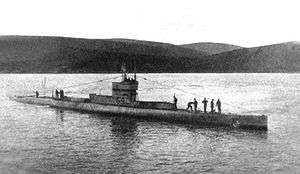HMS G3
HMS G3 was a British G-class submarine built for the Royal Navy during World War I.
 A G class submarine before bow modification. | |
| History | |
|---|---|
| Name: | G3 |
| Builder: | Chatham Dockyard |
| Laid down: | 1 October 1914 |
| Launched: | 22 January 1916 |
| Commissioned: | 13 April 1916 |
| Fate: | Sold for scrap, 4 November 1921 to Young, Sunderland, she was wrecked in Filey Bay after breaking her tow the following month. |
| General characteristics | |
| Class and type: | G-class submarine |
| Displacement: |
|
| Length: | 187 ft 1 in (57.0 m) |
| Beam: | 22 ft 8 in (6.9 m) |
| Draught: | 13 ft 4 in (4.1 m) |
| Installed power: |
|
| Propulsion: |
|
| Speed: |
|
| Range: | 2,400 nmi (4,400 km; 2,800 mi) at 12.5 kn (23.2 km/h; 14.4 mph) surfaced |
| Complement: | 22 |
| Armament: |
|
Description
The G-class submarines were designed by the Admiralty in response to a rumour that the Germans were building double-hulled submarines for overseas duties. The submarines had a length of 187 feet 1 inch (57.0 m) overall, a beam of 22 feet 8 inches (6.9 m) and a mean draft of 13 feet 4 inches (4.1 m). They displaced 703 long tons (714 t) on the surface and 837 long tons (850 t) submerged. The G-class submarines had a crew of 30 officers and other ranks. They had a partial double hull.[1]
For surface running, the boats were powered by two 800-brake-horsepower (597 kW) Vickers two-stroke diesel engines, each driving one propeller shaft. When submerged each propeller was driven by a 420-horsepower (313 kW) electric motor. They could reach 14.25 knots (26.39 km/h; 16.40 mph) on the surface and 9 knots (17 km/h; 10 mph) underwater. On the surface, the G class had a range of 2,400 nautical miles (4,400 km; 2,800 mi) at 16 knots (30 km/h; 18 mph).[1]
The boats were intended to be armed with one 21-inch (53.3 cm) torpedo tube in the bow and two 18-inch (45 cm) torpedo tubes on the beam. This was revised, however, while they were under construction, the 21-inch tube was moved to the stern and two additional 18-inch tubes were added in the bow. They carried two 21-inch and eight 18-inch torpedoes. The G-class submarines were also armed with a single 3-inch (7.6 cm) deck gun.[1]
Career
Like the rest of her class, G3's role was to patrol an area of the North Sea in search of German U-boats.
In December 1921 G3, out of commission, was being towed north to be broken up for scrap when she broke her tether and came ashore at Scalby Mills, north of Scarborough. The submarine later broke free from the shore and drifted back out to sea. She then drifted south, finally running aground under Buckton cliffs in Filey Bay, bow first. A local man, John Webster bought the salvage rights to the vessel and the wreck was scrapped. Lumps of the hulk were lifted up the sheer cliffs using ropes and pulleys, the salvers using rope ladders for access. The remains of the wreck lie under the cliffs at Buckton including about 60 feet (18 m) of the base of the hull, two diesel engines and their drive gear.
Notes
- Gardiner & Gray, p. 90
References
- Colledge, J. J.; Warlow, Ben (2006) [1969]. Ships of the Royal Navy: The Complete Record of all Fighting Ships of the Royal Navy (Rev. ed.). London: Chatham Publishing. ISBN 978-1-86176-281-8.
- Gardiner, Robert & Gray, Randal, eds. (1985). Conway's All the World's Fighting Ships: 1906–1921. Annapolis, Maryland: Naval Institute Press. ISBN 0-85177-245-5.
- McCartney, Innes (2008). British Submarines of World War I. New Vanguard. 145. Oxford, UK: Osprey. ISBN 978-1-84603-334-6.